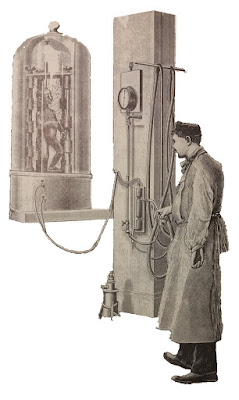As we don't know when Murphy was born or died, his admirers celebrate the anniversary of his leaving Sydney on March 29.
* * *
While Murphy’s Law is
commonly quoted in laboratories all over the English-speaking world, few have
heard of the tragic life of the original Murphy, a man whose life makes one of
the saddest stories in the history of science.
The disasters and near-disasters
began surrounding him almost as soon as he was born, and dogged him all of his days. For
example, Murphy was to be named after the novelist Charlotte Bronte, and was
only saved the ignominy of being called Charlotte because the registry clerk
who handled the case was cross-eyed.
As an adult, Murphy
began to study the mathematical theory of disasters, parallelling the much
later ‘catastrophe theory’ almost exactly. Failing to get recognition for his
work in Europe, Murphy packed his belongings into a large crate, together with
some of his new patent magnets, and sailed for Australia in the sailing vessel Dunbar.
His magnets were another
failure, as they tended to change their polarisation without warning, and
sometimes even to develop identical poles at both ends, at which point the magnets
would repel themselves into a small heap of iron filings.
There are those who
maintain it was Murphy’s magnets (the ones which survived the long trip) that
caused the Dunbar to be wrecked at
the Gap near Sydney, when they affected the ship’s compass. We will never know
now: but we do know his records of his disaster theory were all destroyed in
the wreck, save for a few tantalising scraps which he painstakingly wrote out
in his old age, only to see them eaten almost immediately by a passing rat.
Soon after his arrival
in Sydney, Murphy married, and soon the union was blessed with several
children, causing the strongly religious and ecstatic Murphy to make his
often-misquoted comment “Thank Heavens for small Murphies”.
 |
| Murphy's shovel refurbisher |
He also worked briefly as a mender of implements, but his "refurbisher" was ahead of its time, requiring electricity which was, at that time, not available in Australia.
The seminal influence
of Murphy on the old cobblers of Sydney who worked in chamois leather will be
apparent to anybody who has read the chapter entitled ‘The Soft Shoe Shovel’,
while the recovery of Australia’s film industry shows the influences he had on
the interpretation of the work of that fine cinematographer, Charles Shovel.
But Murphy’s finest influential hour comes in his definitive interpretation of
the explorers X. Hume and Shovell. These two fine examples of the sun-bronzed
pre-Anzac gave rise to the expression digger and browned which many years
earlier had been expressed in the music of Bach, according to some
commentators.
This of course, is
totally wrong, for Bach’s music was notably contrapuntal, and, in spite of the
claims of his more strident critics, Murphy was admirably unopposed to puns.
His critics even offer quotations to prove their case, but we now know that
what Murphy actually said was that the bun was the lowest form of wheat. Regrettably, it seems that the agricultural reporter to whom he spoke had been keeping an ear to the ground, and still had mud in his ears.
That said, his music was very modern and most of his works were destroyed by outraged music lovers. For example, the illustration on the left shows the only surviving portion of his Coffee Can't Hurt Her, scored for prepare lagerphones and unprepared soprano.
It is believes that this fragment represents the moment when the trap door opened under the lagerphone players. It seems that they were less prepared than they should have been.
That said, his music was very modern and most of his works were destroyed by outraged music lovers. For example, the illustration on the left shows the only surviving portion of his Coffee Can't Hurt Her, scored for prepare lagerphones and unprepared soprano.
It is believes that this fragment represents the moment when the trap door opened under the lagerphone players. It seems that they were less prepared than they should have been.
In the end, Murphy
turned from rural themes to the study of suburban agriculture, and he wrote a
short treatise (To the Victa Belongs the
Soils) on what he mistakenly took to be a New Zealand invention, the
Rotorua moa. Shortly after, Murphy left Sydney on the brig Hesperus, and was never seen again.
* * *
Post script : If you
are going to make your way in the world of science, you need to be able to
recognise nonsense when you run across it. I suggest that you analyse the
strange tale of Henry Handel Murphy, and identify the key points that you
believe to be true facts, and the key points that are complete nonsense.
Much
of the pseudo-science you encounter will be like this: a mixture of easily
checked facts, and a great deal of rubbish. If you were fooled, perhaps you
should read the section on pseudo-science in other places. Or come
and talk to me about the swamp land I have for sale . . .



